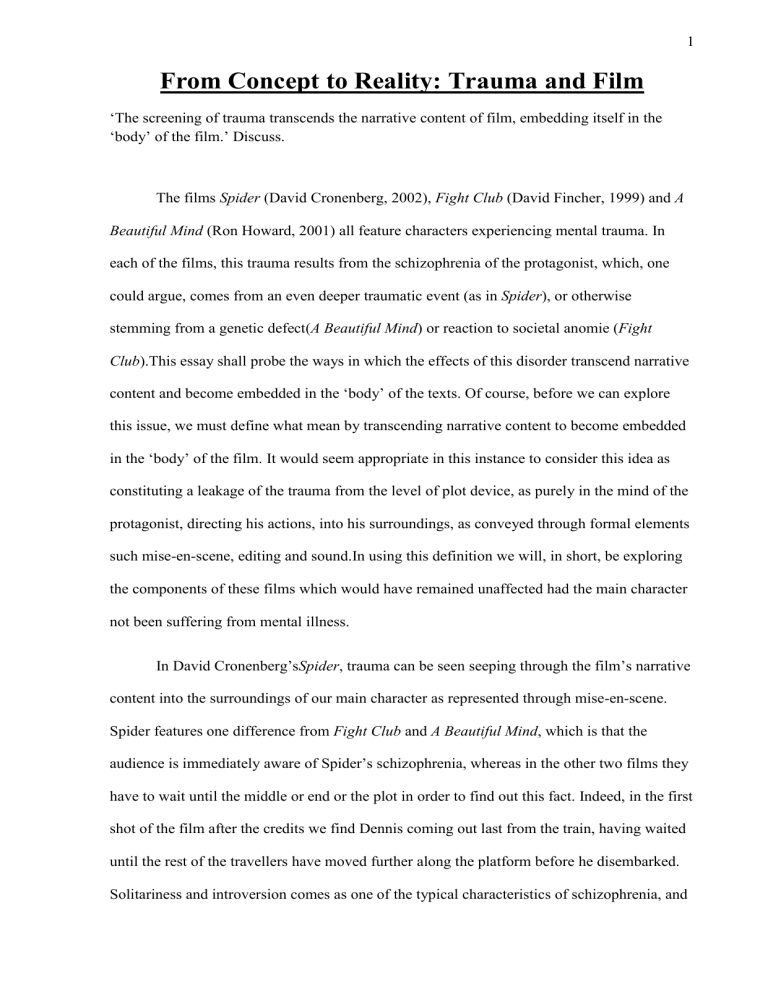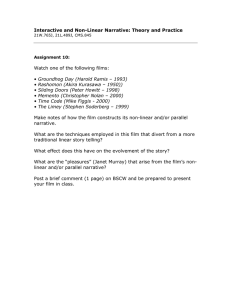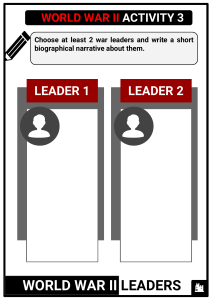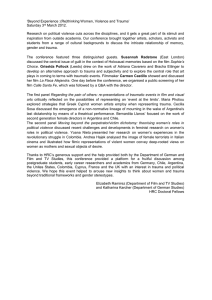
1 From Concept to Reality: Trauma and Film „The screening of trauma transcends the narrative content of film, embedding itself in the „body‟ of the film.‟ Discuss. The films Spider (David Cronenberg, 2002), Fight Club (David Fincher, 1999) and A Beautiful Mind (Ron Howard, 2001) all feature characters experiencing mental trauma. In each of the films, this trauma results from the schizophrenia of the protagonist, which, one could argue, comes from an even deeper traumatic event (as in Spider), or otherwise stemming from a genetic defect(A Beautiful Mind) or reaction to societal anomie (Fight Club).This essay shall probe the ways in which the effects of this disorder transcend narrative content and become embedded in the „body‟ of the texts. Of course, before we can explore this issue, we must define what mean by transcending narrative content to become embedded in the „body‟ of the film. It would seem appropriate in this instance to consider this idea as constituting a leakage of the trauma from the level of plot device, as purely in the mind of the protagonist, directing his actions, into his surroundings, as conveyed through formal elements such mise-en-scene, editing and sound.In using this definition we will, in short, be exploring the components of these films which would have remained unaffected had the main character not been suffering from mental illness. In David Cronenberg‟sSpider, trauma can be seen seeping through the film‟s narrative content into the surroundings of our main character as represented through mise-en-scene. Spider features one difference from Fight Club and A Beautiful Mind, which is that the audience is immediately aware of Spider‟s schizophrenia, whereas in the other two films they have to wait until the middle or end or the plot in order to find out this fact. Indeed, in the first shot of the film after the credits we find Dennis coming out last from the train, having waited until the rest of the travellers have moved further along the platform before he disembarked. Solitariness and introversion comes as one of the typical characteristics of schizophrenia, and 2 even audience members with a lack of medical or filmic knowledge should be able to work out straight away that there‟s something not quite right with Dennis mentally.By immediately giving away the information that Spider is schizophrenic, the film serves to instantly put meaning into what we see around him, for in being aligned with him, as we are initially when we meet him on the platform like a family member come to greet him, we comprehend our position as experiencing Spider‟s worldview.This is important, for now we can look for ways in whichDennis‟s trauma has leaked outside of his mind and actions, or in other words has transcended the film‟s narrative content, and embedded itself into the „body‟ of the text as represented through mise-en-scene, editing and sound. With Fight Club and A Beautiful Mind, although not a problem in critically analysing them with repeated viewing, the spectator‟s lack of preliminary knowledge makes some elements of the films difficult to understand artistically on a first reading. Moving on, then, to the ways in which trauma has leaked out from Dennis‟s mind to infect the mise-en-scene of Spider, we can find his disorder reflected time and again in his surroundings during the film, as well as in the costume of Fiennes‟s character.The decrepit corridors and low lighting in the half way house reflect Spider‟s „unhealthy‟ state of mind, the dirty bath water also serving as another prime example of this notion. This is in contrast to those scenes in which Dennis revisits his past memories of childhood, before the death of his mother and the truebeginning of his disorder, which feature impeccably clean and „healthy‟ rooms, conveying the comparative sanity of the young Dennis to his older self. The contrast between these two representative settings confirms that trauma in Spidertranscends the narrative with varying extent to embed itself in the „body‟ of the film, materialising here through different levels of dirt in Dennis‟s surroundings, as represented through mise-en-scene. In terms of costume, Dennis‟s trauma is represented through his wearing four shirts, as discovered by Mrs Wilkinson during a breakfast meal at the half way house. This excessive amount of clothing theoretically serves for Spider as some kind of defence against the outside world, something in linewith my proposition in the introduction 3 that in exploring trauma in Spider and the other two films we are exploring the components of the texts which would have remained unaffected had the main character not been suffering from mental ilness; if Spider did not have schizophrenia, he would supposedlynot feel the need to wear four shirts to protect himself fromevents beyond his control. Dennis‟s clothing thus serves as another example of where trauma has transcended Spider‟s narrative content, in the sense of being necessary to plot development, to embed itself in the body of the film. In another direction, the trauma leaking from the narrative content into the „body‟ofSpider comes represented as a puzzle in the film‟s mise-en-scene. One scene in particular deserves examination, which is the short sequence in which Dennis is playing a jigsaw puzzle at the half way house. This activity metaphorically embodies Spider‟s struggle to piece his mind back together, to form his memories into a coherent life history. While engaging with the jigsaw Dennis relives his past, with a cut at one point to a memory in which his younger self finds his mother trying on dresses that she hopes her husband will find sexually arousing. Cutting back to the present, Dennis, having found his experience overwhelmingly agonising, starts to rip apart the jigsaw and writhe around on the table he was been working at. Seemingly for some oedipal reason he finds this particular memory so distressing to recall that he immediately stops his effort to reconstruct his past because of the emotional pain the pursuit has just caused him. Mise-en-scene in this sequence, then, portrays the “internal shattering of a single subject”1 which characterises schizophrenia.Overall, in terms of trauma transcending the narrative content of Spider and embedding itself in the film‟s „body‟ or formal elements, Dennis‟s schizophrenia can be seen as leaking into the film‟s mise-en-scene, which presents the problems resulting from his disorder as a puzzle to bepieced back together. A further way in which mise-en-scene in SpiderdepictsDennis‟s trauma in his surroundings is through his construction of webs around his personal space. These physical structures, representing on a symbolic level the connections in Dennis‟s brain, serve as a way 4 of helping him piece together the puzzle of his past. Indeed, according to Patricia MacCormack, “In psychoanalysis our webs are unusually internalised but Spider builds webs and externalises his trajectories, resonating with his externalisation of his phantasies, wishes, memories and hallucinations.”2 This means that Dennis has placed outside of his body the various parts of his fragmented mind, allowing him to comprehend them in a more concrete manner. This is important for him when dealing with a condition founded often on delusion and hallucination. Indeed, Spider‟s trauma ultimately results both from “his mother‟s death and the actual murder of his mother he commit[ted] as the murder of Yvonne”3, a narrative script which highlights his dual nature in understanding the events of his childhood. As victim, Dennis identifies his mother‟s death with the depraved activity of his father and the local prostitute, while as murderer he identifies her death with his delusional beliefs as a child and the repression and confabulationhe used to cover up the trauma his act of killing her caused him. If we divagate a little, exploring Spider‟s psyche, we can see that, as Maurice Merleau-Ponty says, “The lunatic, behindhis ravings, his obsessions and lies, knows that he is raving, that he is allowing himself to be haunted by an obsession.”4This proposition sees trauma sufferers as capable of remembering the past despite their apparent ignorance. An article in the journal Current Directions in Psychological Science from 2003 seems to confirm this, stating that “individuals reporting [recovered traumatic memories] are characterised by a heightened proneness to form false memories in laboratory tasks”5, highlighting the ability in those having suffered trauma to forge false memories despite being fully aware of what happened in reality. Thenotions these quotes put forwardmight, then, offer a better explanation for why Dennis becomes soagitated after remembering his mother trying on a dress while he was putting the jigsaw together. He remembered how beautiful and caring she was and how he was the one that killed her, and this caused him incredible emotional pain.Thus, Dennis‟s construction of webs around his personal space constitutes both asymbolic attempt at the level of narrative to rebuild his fragmented past (which is 5 arguably not fragmented at all), as well as a physical manifestation of the trauma that has leaked out of Dennis‟s mind. Overall, David Cronenberg‟sSpider depicts in various ways through mise-en-scene the transcendence of trauma from the level of narrative to the level of the film‟s formal elements, the text‟s „body‟. David Fincher‟s Fight Clubportrays trauma as transcending the film‟s narrative and embedding itself in its „body‟ in more varied ways that Spider, possibly because schizophrenia plays a much more visible role in the plot. We can in the text see the Narrator‟s trauma leaking into the mise-en-scene via the actions of Tyler Durden, the editing through subliminal messages and non-classical patterns of cutting, and the soundtrack by means of temporal changes. Beginning withmise-en-scene, we can see that, as with Spider, the protagonist‟s level of mental health in the film is reflected in the extent to which his surroundings are unclean and disorganised. When at the start of Fight Club Edward Norton‟s character is seemingly sane, his apartment is depicted as incredibly clean, while upon moving in with Tyler and (unknowingly) indulging his schizophrenia, his surroundings become rotting walls riddled with damp, piles of cluttered junk, dirty mattresses and rank toilets. The latter setting quickly becomes a metaphor for the Narrator‟s damage mind, with the frequent necessity of cutting the power serving as, metaphorically, Tyler‟s periods in control of Edward Norton‟s body. Thus mise-en-scene in Fight Clubdepicts trauma as transcending the narrative content of the film and embedding itself in the „body‟ of the text through varying level of uncleanliness and disorganisation in the surroundings of the protagonist. The mise-en-scene of Fight Club represents the leakage of trauma from the level of narrative content into the „body‟ of the film in two other ways. The first is through the visual isolation of the Narrator at times during the film, and the second is through a seemingly edited shot showing what happens when the narrator has been completely taken over by his 6 schizophrenia (as personified by Tyler). Dealing with the first argument, we can see Edward Norton‟s character portrayed as highly isolated from other human beings (excluding the fictional Tyler) at many times during the film, such as when the pair play golf outside Tyler‟s house, in which they are “alone for a half mile in every direction”. The scene features several high-angle crane shots, looking down at Tyler and the Narrator and showing their remoteness from society. According to the NHS website for Great Britain, schizophrenia manifests itself in a “withdrawal [from society] or lack of [social] function”6, and therefore the film‟s imagery here canbe seen as reflecting the narrator‟s mental disorder, despite the audience not being aware at this point in the film that the Narrator‟s disorder exists at all. The mise-en-scene at certain times in Fight Club, then, can be seen as reflecting the Narrator‟s trauma beyond the level of narrative content. In terms of the latter argument, the shot mentioned is the one in which Tyler looks directly at the camera, ostensibly breaking the fourth wall, and says “You are not your job. You are not how much money you have in the bank. You are not the car you drive. You are not the contents of your wallet…” This shot seesthe whole of the cinematic image begin to convulse, so that even the imaginary sides of the celluloid film strip come into view.In its method ofconveying the concept of mise-en-scene representing the leakage of trauma from the level of narrative to the level of formal element, this shot is unique in terms Spider, Fight Club and A Beautiful Mind. It depicts the only moment in all these films when trauma spills, not leaks, onto the screen, so much so that the physical, real life film strip begins to shake uncontrollably.As far as trauma transcending the narrative content and embedding itself into the „body‟ of the film goes, then, this is the most extreme moment of the text. Thus the mise-en-scene of Fight Club represents the leakage of trauma from the level of narrative content into the „body‟ of the film through images of the protagonist‟s isolation and a shot showing what this concept would look like cinematically, in extremis. In terms of trauma transcending the narrative and embedding itself into the „body‟ of the film as represented through editing and sound, three short sequences are worthy of 7 remark. The first two, relating to editing, see Tyler Durden performing fantastic feats. The first of these, the ,opening half hour of Fight Club, arguably more a section of the film that a sequence, introduces Tyler through flashing subliminal images of him during events in Narrator‟s daily life (such as going to the doctor‟s or taking part in a testicular cancer meeting). These subliminal images serve no narrative purpose, for the Narrator does not even see them. They therefore can be considered as expressing how the trauma of Edward Norton‟s character has infected the film‟s editing. The second, occurring at the end of the film, finds Tyler move via a cut from one side of a glass door to the other. Here editing is used for the narrative effect of showing that the Narrator cannot escape his “Imaginary friend”. Beyond narrative, though, this sequence shows how the Narrator‟s mental disorder permeates the editing patterns of Fight Club.Regarding sound, the sequence in which Tyler and the Narrator engage in a play fight outside Lou‟s Tavern serves as an example of where trauma transcends the narrative content of the film and embeds itself in the music of the text. At the point when Tyler punches the Narrator and the latter declares “That really hurts”, there is a temporal change in the music from a charged atmospheric tune to a slow ominous beat. This change does not serve any concrete narrative purpose, but instead demarcates the moment when the Narrator begins to believe in the physicality of his personified trauma.Because of its special relationship with the schizophrenia of Edward Norton‟s character, music reveals itself as an example of where trauma has transcended the narrative content of Fight Club, and embedded itself into the „body‟ of the film as represented through its formal elements. Overall, David Fincher‟s Fight Clubportrays trauma as transcending the film‟s narrative and embedding itself in the „body‟ of the text through the formal elements of miseen-scene, editing and sound. In Ron Howard‟s A Beautiful Mind, we find trauma transcending the narrative content of the plot to pervade the film‟s mise-en-scene and feature occasionally in its editing. Turning first to mise-en-scene, we see many of the same techniquesused to depict this idea in 8 Spiderand Fight Club, such as the schizophrenia of the protagonist being reflected in his surroundings,the visual isolation of the protagonist from wider society, and the external construction of the protagonist‟s internal mental processes. We can regard John Nash‟s schizophrenia as represented in the costume of his (imaginary) roommate Charles. Charle‟s shabby clothing –his lack of tie and shirt not tucked in or buttoned up – mirrors John‟s disorganised state of mind. The fact John always meets his phantasy acquaintances alone, in places and at time when no one else is around, such as his meeting with William Parcher outside the university building at night, also establishes his schizophrenia cinematically beyond the level of narrative (as, like in Fight Club, the audience is not aware of the protagonist‟s mental disorder at this point in the film) and into the formal elements of the text. And the externalisation of Nash‟s mental processes (although this time unrelated to trauma) can be found in is his writing maths problems on the windows of the Princeton Library. A Beautiful Mind, however, does introduce one new technique in which mise-en-scenedepicts trauma‟s transcendence from the level of narrative into the „body‟of the film. This technique is the portrayal of what trauma leaves behind, the things, which, as proposed in the introduction, would have remained unaffected had the protagonist of the film not been suffering from mental ilness. The letters John leaves in the letter box at the abandoned mansion, coming back into the story later on in the film as decrepit pieces of paper in the hands of Alicia as she visits him in the mental institution, serves as an example of this portrayal, representing as they doan element of John‟s psyche in physical form. Thus A Beautiful Mind sees trauma transcend narrative content to pervade the „body‟ of the text as constituted by the formal artistic element of mise-en-scene.Moving on to editing, one scene in particular is worthy of exploration, which is the sequence where Alicia discovers John‟s secret workhouse in the woods behind their property. After rushing back to discover John leaving their babyunder the dangerous care of the imaginary Charles, John begins having a full blown mental hallucination which brings together all his schizophrenic fantasies. 9 Containing rapid and non-classical cutting - at one point breaking the 180 degree rule to show Parcher shift impossibly quickly from one side of John to the other - the scene portrays the transcendence of John‟s mental trauma from the level of narrative device to the level of the formal element of editing, one „limb‟ of the film‟s „body‟. Overall,ABeautiful Mind sees trauma transcending the narrative content of the plot to feature prominentlyin the film‟s mise-en-scene and with powerful impact in its editing. In conclusion, our exploration of Spider, Fight Club and A Beautiful Mindshows that trauma again and again transcends the narrative content of film to embed itself in the formal elements of mise-en-scene, editing and sound which constitute the „body‟ of a text. The concept of the personal comes as particularly important wheninvestigating this issue, with mise-en-scene maintaining a special relationship to the spatial area around the „bearer‟ of the trauma, editing a special relationship to the portrayal of the protagonist in moments of personal crisis, and sound a special relationship to him in moments of personal change. 1 Patricia MacCormack, “Phantasmatic Fissures: Spider” in Sense of Cinema, (Issue 27, 2003), p. 3. Patricia MacCormack, “Phantasmatic Fissures: Spider”, p. 4. 3 Patricia MacCormack, “Phantasmatic Fissures: Spider”, p. 3. 4 Maurice Merleau-Ponty, Phenomenology of Perception, trans. Colin Smith, (Routledge, 2002), p. 144. 5 Richard J. McNally, “Recovering Memories of Trauma: A View from the laboratory”, Current Directions in Psychological Science, Vol. 12., No. 1, (Sage Publications, Inc., Feb 2003), p. 32. 6 “Schizophrenia – Symptoms”, last modified November 11th, 2010, http://www.nhs.uk/Conditions/Schizophrenia/Pages/Symptoms.aspx. 2 10 Bibliography MacCormack, Patricia, “Phantasmatic Fissures: Spider” in Sense of Cinema, (Issue 27, 2003), pp. 3-4. Merleau-Ponty, Maurice,Phenomenology of Perception, trans. Colin Smith, (Routledge, 2002), p. 144. McNally, Richard J., “Recovering Memories of Trauma: A View from the laboratory”, Current Directions in Psychological Science, Vol. 12., No. 1, (Sage Publications, Inc., Feb 2003), p. 32. Unknown author, “Schizophrenia – Symptoms”, last modified November 11th, 2010, http://www.nhs.uk/Conditions/Schizophrenia/Pages/Symptoms.aspx. Filmography A Beautiful Mind, d. Ron Howard, 2001, USA, Universal Pictures, Dreamworks SKG, Imagine Entertainment Fight Club, d. David Fincher, 1999, USA/Germany, Fox 2000 Pictures, Regency Enterprises Spider, d. David Cronenberg, 2002, Canada/UK, Odeon Films



